Is the Swiss property market overheating?
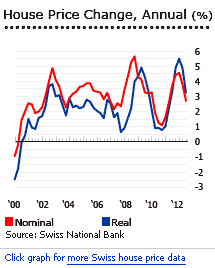
The Swiss housing market is now showing signs of overheating, as property demand and house prices continue to rise in Q3 2012. Rents also continue to rise, which is reassuring, though not as much.
During the year to end-Q3 2012:
- The price of owner-occupied apartments rose by 6.3% (6.9% in real terms), according to the Swiss National Bank (SNB), the country’s central bank.
- The price of single-family homes increased by 3.6% (4.2% in real terms)
- The house price index for rental apartments in old buildings rose by 2.72% (3.27% in real terms)
The Swiss housing market experienced robust price increases from 2000 to 2011:
- Prices of owner-occupied dwellings increased by 62.1% (49.9% in real terms)
- Prices of single-family homes rose by 41% (30.4% in real terms)
- Prices of rental apartments in old and new buildings rose by 41.1% (30.8% in real terms)
The Swiss real estate bubble index devised by UBS, an indicator of the health and viability of the housing market, suggested that the Swiss property market edged up into the risk zone in Q3 2012, for the first time since the country’s 1980s real estate bubble. The UBS Swiss real estate index climbed to 1.02 in Q3 2012, up from 0.82 the previous quarter, pushing it above 1.0, which UBS considers the threshold for risk emergence in the property market. However it is important to note that “risk” is different from “bubble” and UBS is not yet saying that there is a bubble.
The index classifies values into five categories in order of increasing risk: slump (below -1), balance (between -1 and 0), boom (between 0 and 1), risk (between 1 and 2) and bubble (above 2).
The real estate bubble index is based on the following sub-indices:
- Home prices relative to annual rent: In Q3 2012, the ratio between house prices and rents increased from the previous quarter and now stands at 28.1. This means that purchase prices continue to rise much more quickly than asking rents.
- Home prices relative to household income: The ratio between house prices and annual household income rose to 5.9 in Q3 2012, up from 5.8 in the previous quarter.
- Construction relative to GDP: The share of construction activity in GDP is equivalent to 9.1%, below the long-term average.
- Home prices relative to consumer prices: In Q3 2012, house prices continue to rise while consumer prices were down by 0.2% from the previous quarter.
- Mortgage volume relative to income: Mortgage volume continues to rise sharply, as incomes stagnate.
There are several possible reasons for the continued strength of the Swiss housing market:
- Low interest rates, which resulted to record low mortgage rates, spurred strong real estate demand.
- Low vacancy rates, as low as 0.1% in Zurich and Lausanne, are also putting an upward pressure on house prices.
- Switzerland is widely viewed as a “safe haven” by wealthy foreigners.
- An increase in the number of immigrants has led to higher demand for houses. Over the past four years, net migration totaled 330,000 people.
- After the collapse of house prices in other countries, Swiss citizens and residents moved their investments back to the domestic housing market which is relatively more stable.
- The Swiss economy emerged from recession in mid-2009, and the economy expanded 3.03% in 2010 and by 1.93% in 2011. However, economic growth is expected to slow to 0.9% in 2012, amidst the euro area’s fiscal crisis and waning demand for its export products.
Mortgage interest rates in Switzerland are very low. The average variable mortgage interest rate (not linked to a base rate of interest) was 2.99% in July 2012, almost unchanged from a year earlier, according to figures from the SNB. On the other hand, the average fixed mortgage interest rate was 1.68% in July 2012, down from 1.99% in the previous year.
In Q2 2012, the total number of new apartments completed rose by 19.6% to 10,647 units from the previous quarter, but down 8.2% from a year earlier.
The total number of apartments under construction increased by 6.1% q-o-q and by 5.9% y-o-y to 74,040 units in Q2 2012. On the other hand, the total number of new apartments authorized rose by 22.4% to 15,007 units in Q2 2012 from the previous quarter but down by 10.3% from a year earlier.
The metropolitan areas of Zurich, Geneva, and Lausanne, as well as low tax locations like Zug and Alpine tourist resorts such as Davos have experienced the sharpest house price increases in recent years and are among the areas most threatened by overheating, according to the UBS report.
"Although population growth continues to favor price increases, high prices are increasingly being supported by the demand for real estate as an investment as well as by low interest rates, and the strong increase in household mortgage debt is showing no signs of abatement," Claudio Saputelli, head of UBS real estate research unit said. "This represents a dangerous trend, as both drivers could easily be thrown into reverse and therefore trigger a price correction," Saputelli added.
In an effort to cool the housing market, the country’s regulator, Swiss Financial Market Supervisory Authority (FINMA), toughened mortgage lending standards in July 2012. However, the SNB has been forced to keep its key interest rates at record low to prevent the Swiss franc from appreciating at an uncontrollable pace.
The Swiss have for a long time restricted the sale of property to foreigners. Now the Federal government has set an annual quota of permits for non-resident foreigners seeking to acquire property in Switzerland. In addition, cantonal authorization is needed before gaining a title. Each canton has slightly different rules, varying from commune to commune within the canton.
However in 2010 each canton gains responsibility for its own foreign property acquisition laws, which will result in faster transfer of property titles.
Foreigners cannot acquire residential real estate for buy-to-let investments except for subsidized housing, which has below market rents.
The 1990s - a crashing decade

Swiss apartment prices boomed during the late 1980s and early 1990s, with rental apartment prices rising on average by 14% annually from 1988 to 1991.
Other properties’ prices rose strongly too. Single-family homes rose on average 13.87% a year from 1988 to 1989, and owner-occupied flats by 10.4%.
To tame what it saw as runaway house price inflation, the Swiss National Bank (SNB) aggressively raised interest rates. Mortgage rates rose to 7.9% in October 1992, up from 4.9% in January 1989. Since most Swiss mortgages then were variable rate (about 76% of all loans in 1994), the impact was severe.
Apartment prices fell by 9% in 1993, followed by another 9% in 1994, and 8.3% in 1996. From 1993 to 2000, apartment prices fell by an average of 6% yearly. The average price of single-family homes fell by an average of 2.57% annually from 1990 to 1999, while the price of owner-occupied flats fell 2.72% annually from 1991 to 1998.
Stagnating real incomes, slow population growth, weak net migration and increased housing supply led to further house price falls. By 2000, apartment prices were back to their 1987 level. The crash had wiped out a decade’s gains.
Housing market recovery, 2001+
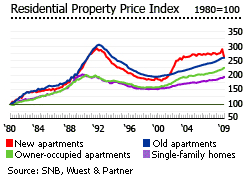
From a peak rate of more than 7% (1990 to 1992), mortgage rates then steadily fell as the SNB eased monetary policy. Mortgage rates dropped to an average of 4.3% in 2000-2001, and 3% from 2003 to 2006. This contributed greatly to the recovery of the housing market, with residential property prices bottoming out between 1999 and 2000.
Other positive factors were an increase in the number of net migrants, and the relaxation of ownership limits in some cantons (states).
Investors quickly snapped up new units when it was clear the housing market was recovering, as new units earn higher rents. Thus while the old rental apartments index rose 29.4% (18.9% in real terms) from 2000 to 2008, the new rental apartments index rose an astonishing 51% (38.6% in real terms), largely caused by a huge jump from mid-2001 to 2002 – the new rental apartments index rose 17.8% y-o-y, while the old rental apartments index rose by a mere 3%.
Developers responded by increasing the supply of new rental units, softening the price increases in 2004 and 2005. Owners of old units also refurbished or renovated their units. The increase in competition led to slower price increases and eventually price falls for new rental units.
Falling interest rates, growing mortgage market
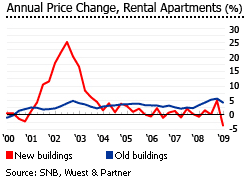
Mortgage rates either fell or remained unchanged from 2004 to 2007. Mortgage rates only started rising in May 2007, and never rose above 3.5% during this period. Outstanding housing loans stood at CHF537.7 (€354) billion at the end of 2008, 74% up on the 2000 level. Much of the growth occurred in 2006, when outstanding mortgages rose 19% on a year earlier.
Switzerland’s mortgage market is one of the largest in the world – comparatively speaking - at more than 100% of GDP, since 2006.
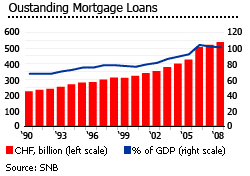
As interest rate cuts were implemented by central banks around the world in Q4 2008, SNB reduced its key rate to almost 0% (0.03% in March 2009).
Mortgage rates are now at historic lows. Average interest rates for 5-year fixed rate mortgages dropped to 2.7% in Q1 2009, the lowest level for five years according to Comparis.ch, a consumer rating agency. Rates for mortgages with 10-year terms also dropped to 3.4%.
Swiss borrowers can choose between fixed and variable mortgages, or combine the two. To minimize risk exposure, mortgages are broken down into several loans, with different maturities and interest rate fixations.
Lenders are generally conservative. Borrowers must produce down payments of 20% to 5% of loan value. In 2004, 91% of all bank mortgages had loan-to-value (LTV) ratios of less than two-thirds of the property value.
Comparis.ch reports that less than 2% of property buyers availed of variable rate mortgages in Q1 2009, down from 22% in Q3 2008. On the other hand, 89% of buyers took fixed rate mortgages, up from 79% in Q4 2008.
Foreign resident population huge
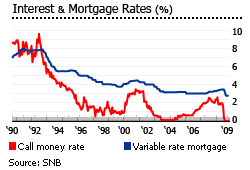
Switzerland has a huge foreign resident population, working in international organizations, private corporations and financial institutions. One out of every 5 persons (20%) in Switzerland is a foreign resident, significantly affecting house price movements.
Foreign residents tend to remain ‘foreign’, because Switzerland has one of the world’s strictest citizenship requirements. It requires 12 years of “permanent, legal, notated” residency, full integration to Swiss culture and community, and mastery of one of the official languages.
The net rate of increase in foreign residents surged to 47,379 in 2007, and 67,984 in 2008, much higher than the average of 22,000 annually from 1999 to 2006, because in June 2007 quotas for EU and EFTA citizens were abolished.
The number of net migrants in 2009 is set to fall to around 60,000 due to the worsening economic outlook. Nevertheless, the inrush of foreign residents continues to boost demand for housing.
Low owner-occupancy rate
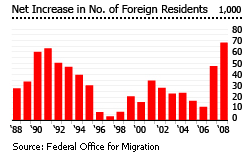
Switzerland has one of the lowest owner-occupancy rates in Europe at 35% (2000), while 64% of all households rent. One reason is extremely pro-tenant laws. Rent increases must be justified by the landlord’s cost increases. Tenants are also protected against eviction.
Owner-occupancy is also discouraged by taxation; property is treated as an asset subject to both wealth and income tax for imputed rental income. Income tax rates in Switzerland can easily exceed 50%, among the highest in the world. Capital gains are also taxed at cantonal level, with rates differing by duration of ownership. (see Taxes and Cost section)
Owner-occupancy, however, is slowly gaining popularity. The home ownership rate reached 36.5% in 2005, up from 31% in 1990, mainly due to an increase in apartment ownership. Changes in pension laws have helped - funds can now be withdrawn for house purchases from all pension accounts, both mandatory and voluntary.
Restricted foreign access
The Swiss have long restricted the sale of property to foreigners. Now the Federal government has set an annual quota of permits for non-resident foreigners seeking to acquire property in Switzerland. In addition, cantonal authorization is needed before gaining title. Each canton has slightly different rules and the rules even vary from commune to commune within the canton.
Generally speaking, foreigners have the largest choice of properties in French-speaking cantons. The most liberal canton is Vaud, which includes mountain resorts such as Villars, where foreigners can buy virtually any property and resell immediately.
However by 2010 each canton will have the responsibility for its own foreign property acquisition laws, which may result to faster transfer of property titles as opposed to the current delays. This is expected to increase demand from foreign buyers.
Not for buy-to-let investment
Even with the gradual opening of the real estate market, the buy-to-let market remains off-limits to foreigners except for subsidized housing. The acquisition of residential real estate by foreigners for rental “requires prior authorization and is prohibited because there are no grounds for granting authorization,” according to the Federal Office of Justice.
A foreigner may be granted authorization to acquire a rental unit if he will construct subsidized housing, i.e. for the building of accommodation with a rent which is low and reasonable compared with similar premises in the same locality, or to acquire newly built housing of the same type when there is a local housing shortage. This reason for authorization applies only in cantons Fribourg, Geneva, Grisons, Jura, Neuchâtel, Ticino, Vaud and Valais.
Rental yields Switzerland’s major cities are quite low, at 3.5% to 5.3%. Apartments in Geneva, home to various international organizations such as the ILO, WHO, WTO, and the Red Cross, have gross yields of 3.5% - 4.6%. In Zurich, Switzerland’s biggest city and the financial capital, apartments have gross yields of 3.7% – 5.3%.
The economic growth slowing
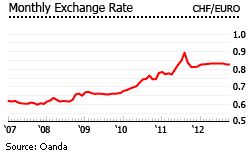
Economic growth was relatively strong from 2004 to 2007, with an average annual GDP growth of 3.2%. However with the global financial crisis, economic growth slowed to 1.9% in 2008. Switzerland officially entered recession in Q1 2009 with the economy contracting by as much as 1.9% in 2009. In 2010, Switzerland’s export-dependent economy bounced back, registering a real GDP growth rate of 3.03%. Then in 2011, economic growth slowed to 1.9%, as exports fell due to the strong Swiss franc.
The year to August 2011 saw a dramatic rise in the value of the Swiss franc. The official exchange rate stood at €1=CHF1.085 in early-August 2011, up 30% on the same period last year, or about 32% against the US dollar.
Because of this, the Swiss National Bank (SNB) introduced numerous measures to halt the franc’s rise:
- The Franc’s money market liquidity was almost quadrupled. SNB boosted its monetary base from CHF30 billion to CHF80 billion. Then in August 10, 2011, SNB announced a further increase to CHF120 billion.
- Currency swaps were introduced
- The key rate was slashed to close to zero in August 3, 2011. The special rate for bottleneck financing facility was 0.59% in June 2011.
- In September 2011, the SNB announced an official 1.20 per euro cap on the strengthening franc.
In October 2012, the official exchange rate stood at €1 = CHF1.2069.
In 2012, economic growth in Switzerland is expected to slow to 0.9%.
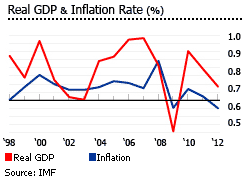
Consumer prices fell by an annualized rate of 0.2% in October 2012. The SNB’s mandate must keep inflation positive but below 2%, according to the Swiss Federal Statistics Office (SFSO). Swiss inflation averaged 0.89% from 1994 to 2007, but rose to 2.4% in 2008 due to high global food and fuel prices, followed by deflation of 0.48% in 2009, and minimal inflation of 0.69% in 2010 and 0.23% in 2011. The inflation rate is expected at 0.6% in 2012 and 0.5% in 2013.
The unemployment rate slightly increased to 3% in October 2012, from 2.9% in September 2012, according to the State Secretariat for Economic Affairs (SECO).